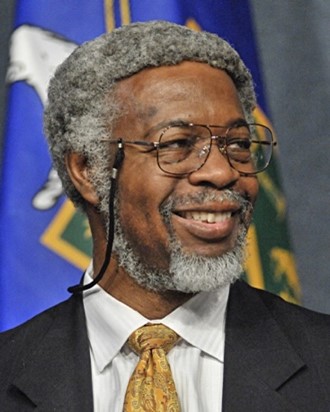Celebrating the Work of Black Physicists Across Fields

The scale of physics is vast, ranging from the study of the smallest particles to the grandest structures of the universe. This Black History Month, I wanted to shine a spotlight on Black physicists who have made significant contributions across various fields, particularly to areas that align with the research clusters that we have here at the University of Liverpool. Despite historical challenges, Black scientists have made groundbreaking advances that continue to shape our understanding of the physical world.
Particle Physics: Professor S. James Gates

An accomplished theoretical physicist, Professor Sylvester James Gates has been a pioneer in the study of string theory, supersymmetry and supergravity. Known for his complex work in mathematics, Prof Gates has dedicated much of his career to uncovering the most fundamental components of our universe. He has published extensively on the topic of supersymmetry and developed graphical techniques known as ‘Adinkras’, which provide a new way to understand complex algebraic structure. Prof Gates’ work has been crucial for advancing the theoretical framework that particle physicists heavily rely on to understand data from experiments from facilities like CERN’s Large Hadron Collider (LHC).
Nuclear Physics: Professor Ciara Sivels

Professor Ciara Sivels, the first black woman to earn a Ph.D. in nuclear engineering from the University of Michigan, is a pioneering nuclear physicist whose work focuses on nuclear non-proliferation and detection technologies. Her research, particularly in the development of advanced radioxenon detectors used to identify nuclear weapons testing, plays a critical role in global security by helping enforce nuclear test bans. Now a professor at Johns Hopkins University’s Applied Physics Laboratory, Prof Sivels is also a strong advocate for diversity in STEM, mentoring underrepresented students and working to ensure a more inclusive future for nuclear science.
Condensed Matter Physics: Professor Shirley Ann Jackson

While Professor Jackson is perhaps best known as the first Black woman to earn a PhD from MIT in physics and for her work in telecommunications, she also made significant contributions to condensed matter physics. Early in her career, she worked on theoretical solid-state physics, including research on the behaviour of superconductors and semiconductors. Whilst serving as the chair of the Nuclear Regulatory Commission, Prof Jackson led international efforts to promote nuclear safety, working in places including post-apartheid South Africa and the countries of the former Soviet Union. The Hutchins Centre for African and African American Research at Harvard University recognised her in 2018 by awarding her the W.E.B Du Bois Medal, which is given to people who have made important contributions to African American history and culture.
Accelerator Science: Professor Lloyd Ferguson

A leading researcher in beam physics, Professor Ferguson played a key role in the development of methods to optimize particle accelerators. These accelerators are crucial for experimental research across multiple fields, including nuclear and particle physics. Prof Ferguson’s work on beam dynamics and his contributions to designing accelerators have paved the way for more precise experiments, enabling scientists to probe deeper into the mysteries of matter and energy.
Astrophysics: Professor Neil deGrasse Tyson

One of the most well-known astrophysicists in the world, Professor Neil deGrasse Tyson has dedicated his career to studying the structure and evolution of the universe as well as advocating for public science communication. As director of the Hayden Planetarium in 2000, he oversaw an exhibit that neither categorised Pluto with the terrestrial or Jovian planets. This decision designated Pluto as a dwarf planet which proved quite controversial. In 2006, the International Astronomical Union (IAU) confirmed this assessment by changing Pluto to the dwarf planet classification. Professor Tyson’s research has inspired countless young scientists (including me) and has brought a greater appreciation for astrophysics into the public eye.
These physicists represent a few of the miniscule percentage of physicists who are Black, whose work has significantly impacted physics. Whilst overcoming stigmas and discrimination and specialising in distinct areas, they share a distinct commitment to expanding our understanding of the universe and the fundamental forces that govern it. By celebrating their achievements, we honour the vital contributions of Black scientists in shaping the future of physics and inspiring the next generation of Black physicists to explore the fascinating world of science. By supporting Black physicists and encouraging diversity in STEM, we can look forward to even more groundbreaking advances in the years to come.
By Adéline Okoboi, 2nd year Astrophysics undergraduate student